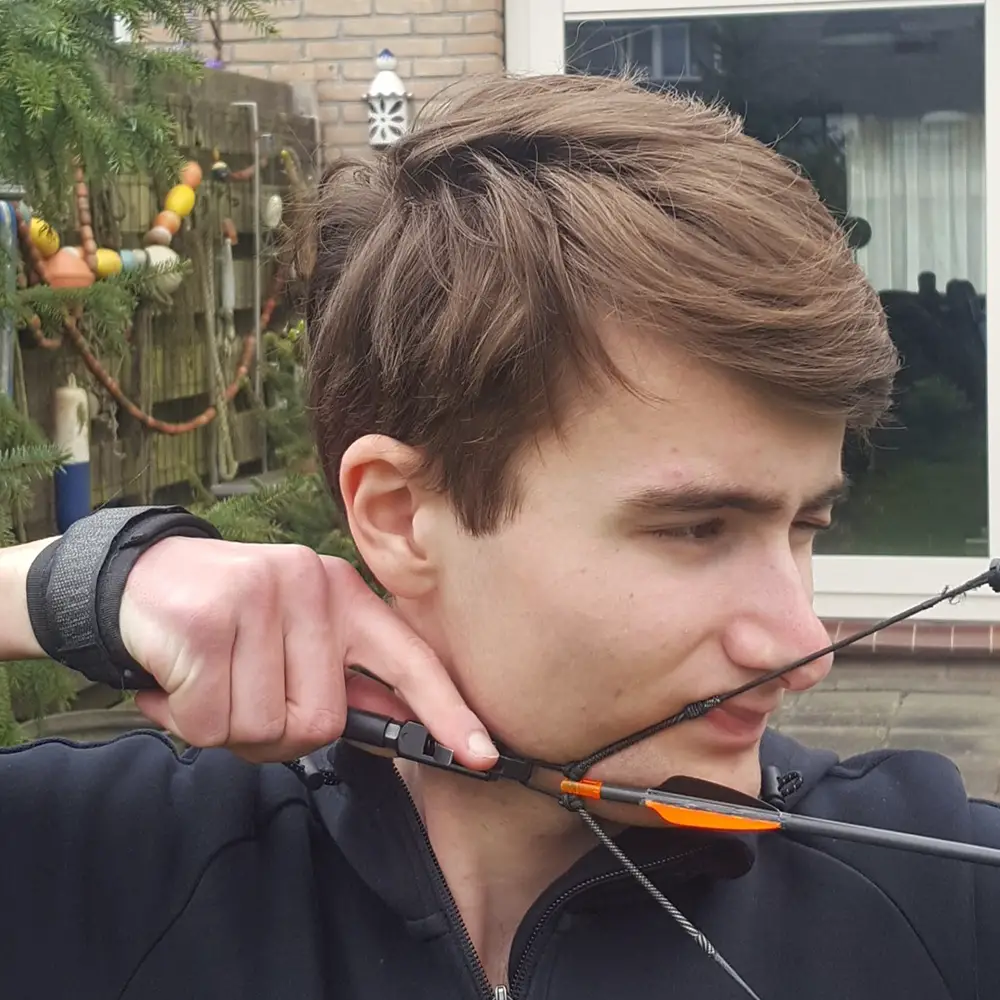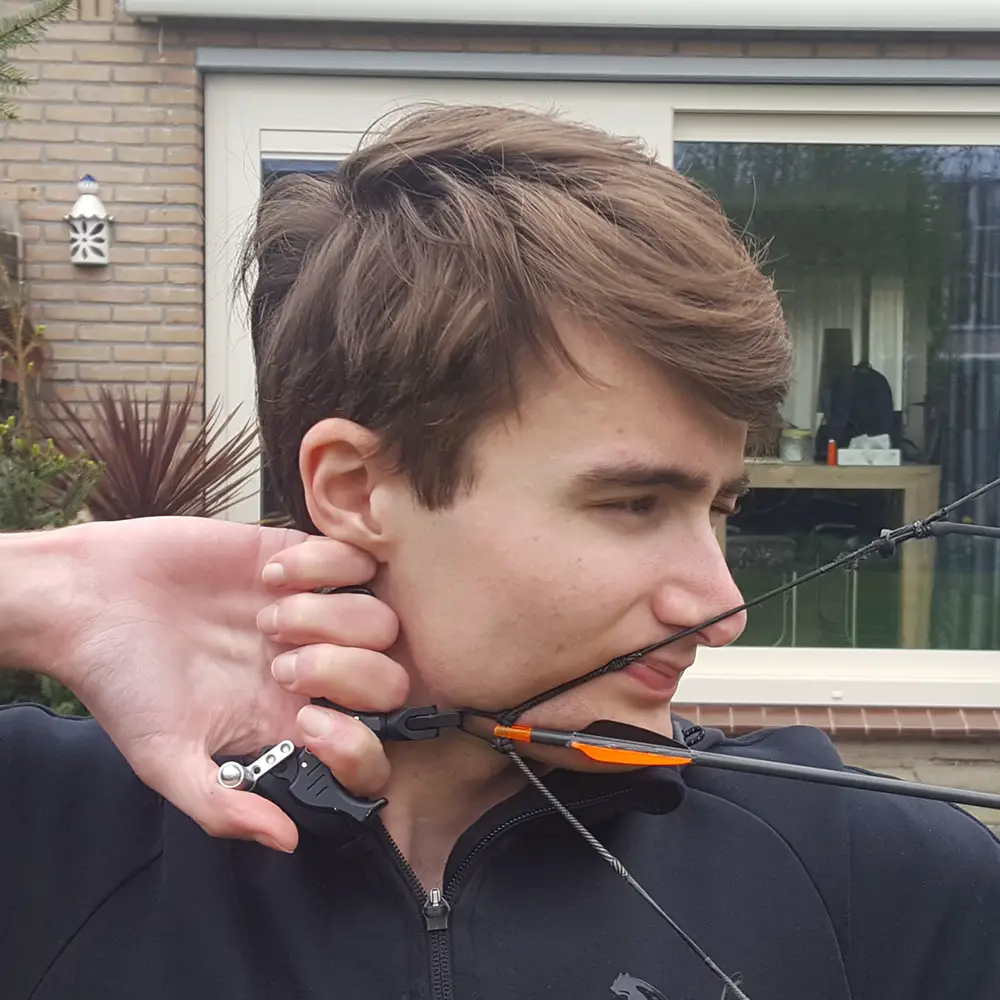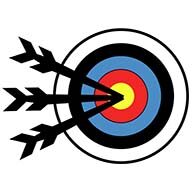Some recurve archers prefer to shoot with a release instead of a tab for a variety of reasons. You may have muscle issues or a condition in your fingers. Some other archers just prefer to shoot with a release because they don’t like to feel the string in their fingers. Therefore there are plenty of reasons why you might want to shoot with a release. But you might wonder whether it is even possible since you almost never see an archer shoot a recurve bow with a release. I won’t force you to read this entire article just to find the answer to your question. Therefore I have provided a short answer below:
Yes, you can safely use a release aid on your recurve bow. There are no technical aspects of the bow, which make it impossible to shoot with a release aid. You only have to replace your nocking points with a D-loop to do so. You can’t, however, participate in recurve competitions with a release.
When you shoot with a release aid, a lot of dynamics of your bow changes. These changes mean that you will probably have to make some changes. In this article I will, therefore, first explain how you shoot a recurve bow with a release. Next I will discuss what changes when you shoot with a release and discuss a reason why you might want to stick with a tab instead. I will also discuss an alternative and answer some frequently asked questions at the end of this article.
How to shoot a recurve bow with a release
As you read in the short answer, there is nothing holding you back from firing a recurve bow with a release. The major technical difference between a recurve bow and a compound bow is the let-off, which is nonexistent on recurve bows. This, however, doesn’t matter at all for a release. Most compound archers shoot with a release, because the angle of the string is steeper. Therefore, it’s very hard and uncomfortable to shoot without a release. If you want to know more about this, I would recommend reading the article below:
Shooting a compound bow without a release
Although nothing is holding you back to shoot a recurve bow without a release, you need to make some adjustments. You can technically click the release directly on the string, but there are many reasons not to do so. First of all, this will wear out the serving on your string. The next major reason is that the release will slide around on the string, which can cause erratic behavior when you draw the bow. Therefore, you should replace the nocking points of your bow with a D-loop. See the video below how to tie a D-loop.
Once you have tied the D-loop you can safely shoot your recurve bow with a release. You can still shoot your bow with a tab after the D-loop is installed, it will only be a bit less comfortable.
What changes when you shoot with a release?
Although swapping out your nocking points is something that can be done within half an hour. The changes you have to make later will involve a lot more time. Since you hold the string and release differently, the dynamics of your bow will change. This may have a bigger impact on your bow than you might first think.
Your anchor point
The first major change when you shoot with a release is the anchor point. If you previously used a tab, you probably anchored below the chin. This isn’t possible or comfortable with a release, therefore most archers anchor behind their jaw, depending on the type of release chosen. Therefore you will have to get accustomed to this new anchor point, which can take at least a few weeks. If you want some extra tips on how to find an anchor point that works for you, I would highly advice reading the article below:
Finding and maintaining your anchor point: tips and tricks
Your draw
When you draw with a tab, you hold your hand vertically with your thumb up. When you shoot with a release, however, this will change. Most archers that shoot with a wrist release which is triggered by the index finger hold their hand horizontally with the thumb facing the cheek. Archers that use a thumb release, on the other hand, hold their hand vertically upside down, with the thumb facing the ground. You can hold a thumb release vertically with your thumb facing the sky, but it will not feel comfortable and you won’t have a solid anchor point.
These changes in your draw can make a big impact on your muscles. When you draw differently, your will use different muscle groups. Therefore, you might experience that it feels more difficult to draw, because you use muscles that are untrained. I experienced this when I switched from a wrist release to a thumb release on my compound bow. When I used this release for the first time, I noticed that I was using completely different muscles, which made the draw a lot harder.
Your draw length
When your anchor point changes your exact draw length will also change. Additionally, the D-loop and the release decrease your draw length with at least an inch. Therefore most compound archers anchor towards the back of the face near the cheekbone. So in general the total draw length will not differ a big deal. But even small changes in the draw length can make a huge impact on the energy transferred to the arrow, since recurve bows exponentially increase in draw weight.
Below you can see the differences between the draw and anchor point of each option: tab, index finger release and thumb release.



Your plunger
When you shoot with a tab, the string will always slip, before it has completely left the hand. This slipping can cause quite a bit of variation within shots. Therefore; archers try to minimize this as much as possible, but it can’t be completely eliminated. The slipping of the string alters the flex of the arrow, which is moderated by the plunger. When you shoot with a release this doesn’t happen, therefore the release is a lot cleaner. Therefore, you might notice that the arrows don’t fly as usual. If this happens, you should try to change the settings of your plunger.
Your sight
The settings of your sights are determined by a lot of factors like the draw length, anchor point, and plunger settings. As we discussed earlier all these dynamics will change, which means that your sight will have to be reconfigured. These changes together can make huge differences, meaning that you have to completely reconfigure your sight.
The biggest difference is caused by the anchor point. Most archers that use a tab anchor below their jaw. This means that the arrow is well below the jawline. When you shoot with a release, the anchor point is often above the jaw bone. This difference is often about an inch, which can make a huge difference at long distances. This means that you probably shoot a lot lower if you keep the same sight settings.
A reason why you might want to stick with a tab instead
In the previous section, I already discussed one reason why you might want to stick with a tab instead. Configuring your bow to be able to accurately shoot with a bow is quite a process. It will involve a lot of steps and it will probably take a few weeks before you can really shoot accurately.
There is another important reason why you might want to stick with a tab. There is a good reason why you rarely see a recurve archer shoot with a release. Competitions that follow the World Archery rules don’t allow you to use a release in the recurve divisions. Since all competitions follow these rules, you will not be accepted within the recurve division. The least restrictive division within the recurve discipline, freestyle recurve archery, doesn’t allow you to use a release. According to the World Archery rules, mechanical releases are only allowed in the compound division.
This doesn’t mean, however, that you can’t partake in any competitions because you have a recurve bow. Recurve archers are always allowed to partake in compound competitions, but you will be at a huge disadvantage. Compound archers shoot heavier bows, have more time to aim due to the let-off, and are overall more accurate. Therefore, it wouldn’t be fun to participate with a recurve bow.
If you really want to shoot with a release, you might want to consider switching to compound archery. The release is one of the features that make compound bows more accurate. The shooting style is more modern and less restrictive than recurve archery, so you might like it more. If you want to know more about the differences between these two shooting styles I highly suggest reading the following article:
The differences between compound and recurve archery
Buying a release or tab
There are a lot of different releases available on the market. Some releases are activated by your thumb and others by your index finger. Some are handheld and others are attached to your wrist. It can be quite a challenge to find the right release. Read the article below if you want more information. I also showcase some releases I recommend.
How to choose the right release aid
If I have convinced you to shoot with a tab, I recommend getting a highly customizable tab. These advanced tabs allow you to completely customize the feel and function of your tab to your hand and shooting style. The cheaper and simpler alternatives are a no-go for serious competition archers. In the article below, I will discuss in more detail what you should consider when buying a tab. I also discuss showcase some tabs I recommend to new archers.
How to pick the right tab – recurve archery
Shooting with a thumb ring release
If you don’t like to draw with your index, ring, and or, middle finger, there is another option. This is especially a good option if you like to shoot a traditional bow. This option allows you to shoot with your thumb by using a special thumb protector. This thumb protector is called a thumb ring and is quite unknown by most archers.
You draw the bow by holding your thumb in a hook while wearing the thumb ring. When you draw the bow you support your thumb with your index finger. The thumb ring protects your thumb against abrasion and pressure from the arrow, therefore this tends to be quite comfortable. It’s even more comfortable than drawing a bow with a tab. When you want to fire the shot, you essentially only have to lift your index finger. Your thumb will automatically be pulled straight by the draw weight of the bow.
If you are interested in this option, I would advise reading the article below from Bow International. I don’t have a lot of experience with this, so their article is a great starting point.
Step by step: the thumb draw – Bow International
Q&A
I hope I answered most of your questions. But you might still have a few, which I will discuss in this section
Will I shoot more accurate with a release?
Compound archers shoot with a release, because it’s very uncomfortable to shoot a compound bow with a tab or glove. This is caused by the steep angle a string has when the bow is fully drawn. Another reason why compound archers use a release is to eliminate, human error from the release. When you release the string with your fingers, the string will always tend to slip. This slip can cause minor inconsistencies. The only way to completely remove these inconsistencies is by removing the direct contact of the fingers with the string. The release essentially mechanizes the release process, which limits the amount of variance in the release.
So, yes you will shoot more accurate with a release. Therefore, it is seen as an unfair advantage to use this in the recurve division. Which explains why it’s banned in this division.
Does the archer’s paradox change?
On another archery blog, an archer mentioned that the archer’s paradox changes when you use a release. Archer’s paradox is the bending of the arrow when the arrow leaves the bow. On recurve bows, the arrow will bend left and right. On compound bows, the arrow will bend up and down. According to his argument, this happens due to the string slipping off the tab when you release the shot. Since this is eliminated, according to him the archer’s paradox will change. This is not true; however, the direction of the archer’s paradox will not change.
Recurve bows have an archer’s paradox that bends left and right because the arrow isn’t perfectly centered on the bow. When you tune a bow, you always point the tip a bit to the right side, to accommodate for the bending of the arrow. This is necessary because the arrow has to bend around the bow. Otherwise, the arrow would hit the riser and glance off to the side.
Compound bows have a ‘’shoot through’’ riser. This means that the arrow shoots right through the center of the bow. Therefore the arrow is set right in the center, and the arrow shoots straight. The arrow will still bend, but this motion is up and down because the arrow is centered.
Therefore, shooting your recurve bow with a release won’t change the direction of the archer’s paradox. If this were the case, you wouldn’t even be able to fire a recurve bow with a release. Since you need the archer’s paradox to go sideways, otherwise it wouldn’t clear the bow, but glance off. For a demonstration of the archer’s paradox, watch the video below.
How to choose the right release?
There are a lot of different releases available. There are releases that you activate with your thumb but also with your index finger. Some releases are attached to the wrist while others are handheld. There are even some specialty releases that trigger on resistance or orientation. In general, I would go with either a handheld thumb release or a caliper wrist release. These releases are the most common and most easy to get used to. Since they are so common there are also a lot of resources available about these types of releases.
If you want to buy a release, however, I would highly advice reading my in depth article about releases. I discuss all the different types of releases available, and what the important differences are. I also give some extra tips, so it’s definitely worth a read:
How to choose the right release aid
Should you adjust the tiller?
No, the tiller should stay exactly the same. On a recurve bow we use a positive tiller, which means that the tiller height is lower on the lower limb. The positive tiller helps to compensate for the fact that the bow is not shot exactly from the center of the bow. Read the article below, for more information about the tiller:
Tiller height – what it is and how to adjust it
Do you have a question that is unanswered?
If you have a question that I haven’t answered in this article, please leave it in the comment section down below. I will not only answer your question, I might also incorporate it in this article. If you leave a valid email address in the appropriate form, you will also get an email with my response. I will answer your question as soon as possible!
Final words
You probably noticed that I am not a fan of shooting a recurve bow with a release. In general, I don’t really see the benefit of it. The release aid is something that has always been part of the compound division; therefore it’s quite unusual to use it on a recurve bow. You might as well switch completely to a compound bow to get the advantage of the let-off and the other features. It would be a bit like screwing a stabilizer on a longbow. Of course, it helps you better aim the longbow, but it doesn’t fit the bow.
But if you want to use a release aid to shoot your recurve bow, you shouldn’t be deterred by me. I only believe it’s a shame that you can’t really compete in any competitions with this setup. Although I currently don’t shoot in competitions, I always want to keep that possibility open. But every archer has to make that choice for themselves.
Tim van Rooijen
For as long as I can remember, I have always been fascinated by archery. First due to its historic significance but later because I like being outdoors. With this blog, I share my knowledge about Archery and how you can improve your shot. More about author…



I want to use a recurve Bow to shoot with a thumb ring with my arrow on the inside. I am right handed. Can I simply use a left handed riser?
Hi Dawn,
I assume that you mean with: ”on the inside” that the arrow is on the other side of the riser? Thus, meaning that you would like to use a left-handed riser, while you are right-handed?
In general, right-handed archers put their arrow on the left side of their bow, because this allows them to aim with two eyes open. If you would do the same thing with a right-handed bow, your riser will block part of your field of view. So if you shoot with two eyes option, it isn’t really an option. I have shot a left-handed bow with my right hand without any issues for quite a while since I always closed one eye.
I am, actually quite curious why you want the arrow on the other side of the riser. Has this something to do with your shooting style with a thumb ring? I am not that familiar with the technique. I’ve done it a few times, but not that much.
Yes. I want shoot Asian/Eastern European style with a thumb ring. That style of shooting was more geared to shooting from horseback. Also, speed shooting works much better shooting from the inside. You might wonder why I’m not buying a recurve Hungarian or Mongolian bow. The better ones are not made in the US & now is not a good time be ordering from over seas.
Ahh okay, sounds good! You have to make sure though that the bow you buy has a grip that also works for right-handed archers. Because those bows are made for left-handed archers. If you buy a metal riser, you can also swap the grip, but that isn’t possible on most wooden recurve bows.
Do I need an even tiller on my recurve to use a release or keep the 1/8 diff
Hi Mike,
Great question! No, you don’t need to change your tiller. We set our tiller height lower for the upper limb because we grip the bow in the center. This means that the arrow is shot just above the center of the bow.
If we wouldn’t compensate for this the upper limb would exert more force on the arrow than the lower limb. To equalize this we make the lower limb stronger by reducing the tiller height.
But since the position of the arrow and your grip don’t change if you use a release, you shouldn’t change the tiller.